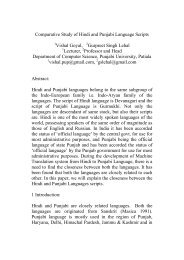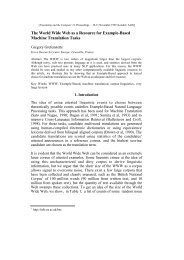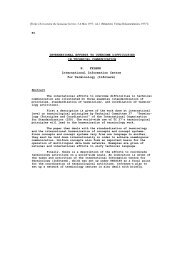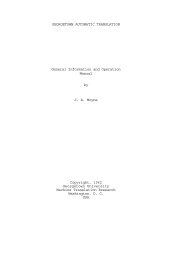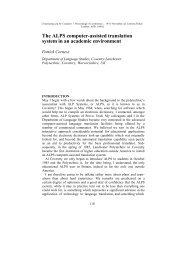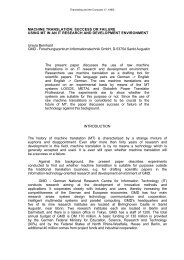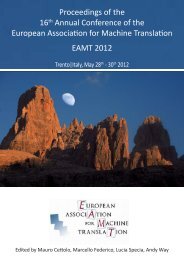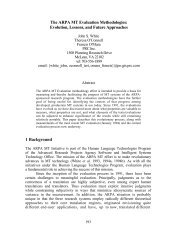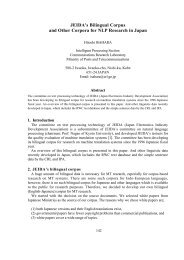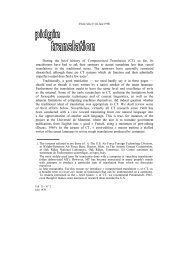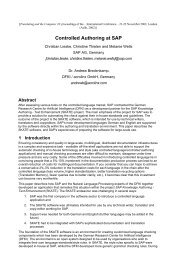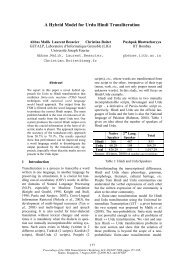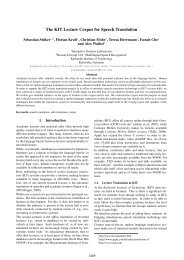MT News International no.18 - Machine Translation Archive
MT News International no.18 - Machine Translation Archive
MT News International no.18 - Machine Translation Archive
You also want an ePaper? Increase the reach of your titles
YUMPU automatically turns print PDFs into web optimized ePapers that Google loves.
taking markers in dialogue, and Jan W. Amtrup (University of Hamburg) on a unificationbased<br />
architecture suitable for spontaneous speech.<br />
The problem of 'natural' generation was tackled by Shiho Ogino and Tetsuya<br />
Nasukawa (IBM Tokyo), describing a method based on shallow discourse analysis; by<br />
Eduard Hovy and Laurie Gerber on using paragraph structure to improve Systran output;<br />
and by Karin Harbusch (University of Koblenz) who sought to define how discourse<br />
representation theory might be satisfactorily introduced into <strong>MT</strong> systems; and Antonio<br />
Sanfilippo (Sharp Laboratories, Oxford) suggested a thesaural approach to lexical selection.<br />
The application of <strong>MT</strong> on the Web was the theme of Yumiko Yoshimura and<br />
colleagues from Toshiba, who described a method for Japanese Web browsers to identify<br />
English texts on sought subjects by means of proper nouns and statistical keyword analysis.<br />
Francis Bond and colleagues described research for the NTT Japanese-English<br />
system in two papers: one on the analysis of temporal expressions (dates, time of day,<br />
weeks, months, etc.), and the other on the treatment of adverbial expressions. On similar<br />
practical lines was the paper from Kazunori Muraki and his NEC colleagues on lexical<br />
frames for selecting Japanese verbs<br />
Efforts to improve <strong>MT</strong> quality were evident in many papers. Kanlaya Naruedomkul<br />
and Nick Cercone (University of Regina) described an iterative approach to quality<br />
improvement, using a combination of HPSG parser, selection constraints and word order<br />
patterns. The languages involved are Thai and English.<br />
The control of input was the theme of Anna Sågvall Hein (Uppsala University), who<br />
described the Multra system for generating English and German translation for the Scania<br />
company from Swedish documents (some 6,000 pages in 1996). A checker for a controlled<br />
language 'ScaniaSwedish' has been developed based on the analysis component of the <strong>MT</strong><br />
system.<br />
Two papers from Spanish researchers were devoted to the finite-state neuralnetwork<br />
model under investigation for the European Union-funded project EuTrans,<br />
basically an example-based system for Spanish and English. The claim is that 'subsequential<br />
transducers' are conceptually simple but computationally powerful finite-state models<br />
capable of incremental improvement from training data.<br />
Other aspects of example-based approaches were discussed in papers by Ralf D.<br />
Brown (Carnegie Mellon University), on using statistical methods for dictionary extraction<br />
for the DIPLOMAT system; and by Brona Collins and Padraig Cunningham (Trinity<br />
College Dublin), on the use of 'adaptation knowledge' of previous successful matches. The<br />
more general problem of word alignment in bilingual corpora was tackled by Mathis Chen<br />
and others from the National Tsing Hua University, Taiwan, arguing for the use of 'topical'<br />
clustering of bilingual dictionary entries.<br />
Arturo Trujillo (UMIST) described a method for improving chart generation in a<br />
lexicalist approach. The shake-and-bake approach was also the inspiration for the work of<br />
Fred Popowich and co-workers at Simon Fraser University and TCC Communications. The<br />
goal is a system for on-line translation of television captions and subtitles from English into<br />
Spanish (and later other languages). An obvious challenge is the treatment of colloquial and<br />
idiomatic language with high level of ambiguity, and within an unrestricted domain. On the<br />
other hand, recipients have the help of the visual images for understanding. It is further<br />
demonstration of the ever widening field of automatic translation to areas inconceivable to<br />
the pioneers of the 1940s and 1950s.



